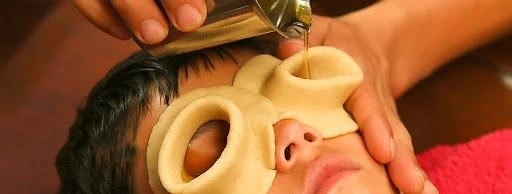Glaucoma in Ayurveda.

Glaucoma in Ayurveda.
World Glaucoma Day, which takes place on the 12th of March of every year, is a unique initiative that puts a spotlight on Glaucoma as the leading cause of preventable irreversible blindness worldwide. The timely diagnosis and treatment of glaucoma can prevent needless vision impairment.
In India, many people are unaware of this disease related to the eyes and its preventive care and treatment.
What is Glaucoma?
Generally, glaucoma disease is caused when the aqueous humor, a natural fluid produced by the eye, fails to drain out naturally from the eye. This extra pressure from fluid inside the eye causes damage to the optic nerve. This is the leading cause of blindness and vision impairment worldwide.
This disease is mentioned in Ayurveda under the heading – Adhimantha. Adhimanth, which is very similar to glaucoma, is well explained by Sushruta in Sushruta Samhita around 5000 years ago under Sarvagata Netraroga.

Samhita says that it is a dreadful disease that causes excessive churning of the eyes and is associated with the particular dosha. An early diagnosis, Ayurvedic herbal formulations for correcting imbalances of dosha, and special local eye-related procedures are three pillars of the treatment of Glaucoma.
The late-stage damage to the optic nerve leads to irreversible, permanent blindness. Therefore, early diagnosis is an important factor.
Glaucoma is the leading cause of irreversible blindness in India, with at least 12 million people affected and nearly 1.2 million blinds. More than 90 percent of cases of Glaucoma are undiagnosed in the community. With increasing age, Glaucoma prevalence increases.
It is therefore important to raise awareness about the symptoms of glaucoma, its treatment, and diagnostic tools related to this disease.
Here are 4As related to Glaucoma which everyone should know about:
1. Awareness about symptoms
The most common type of glaucoma, open-angle glaucoma, often has no symptoms other than slow vision loss. The most common complaints associated with glaucoma are seeing halos around lights, slow vision loss, eye redness, whitening/haziness of the cornea, eye pain, headache, etc.
Therefore, it is important to consult with the doctor immediately for all of the above complaints.
2. Awareness amongst more susceptible groups.
People over the age of 60, people with a family history of glaucoma, and people who have diabetes and hypertension are more susceptible to glaucoma. The above group requires regular screening.
3. Awareness about diagnosis.
After the age of 40, it’s recommended to get an eye checkup every year. Tonometry, Gonioscopy, Visual field test, and Optical nerve assessment can be done along with proper eye examination by the doctor.
4. Awareness about treatment.

Ayurvedic principles and procedures are very effective in treating Glaucoma. The use of herbal medications and panchakarma therapies helps patients reduce eye pressure and restore normal functioning. Panchakarma therapies, such as Virechana, Leech therapy, and Raktamokshan, and special eye-related therapies, such as Anjana, Netratarpan, and Nasya, play a key role in increasing ocular pressure.
Ayurvedic medicines are given for reducing hypertension and pacifying vitiated Dosha. The symptoms associated with glaucoma are also reduced by systemic medicines and local procedures. Surgery is recommended at the end stage of Glaucoma.

Help spread the word about Glaucoma because when eyes get blurry, life gets blurry.
The world is bright, save your sight.

